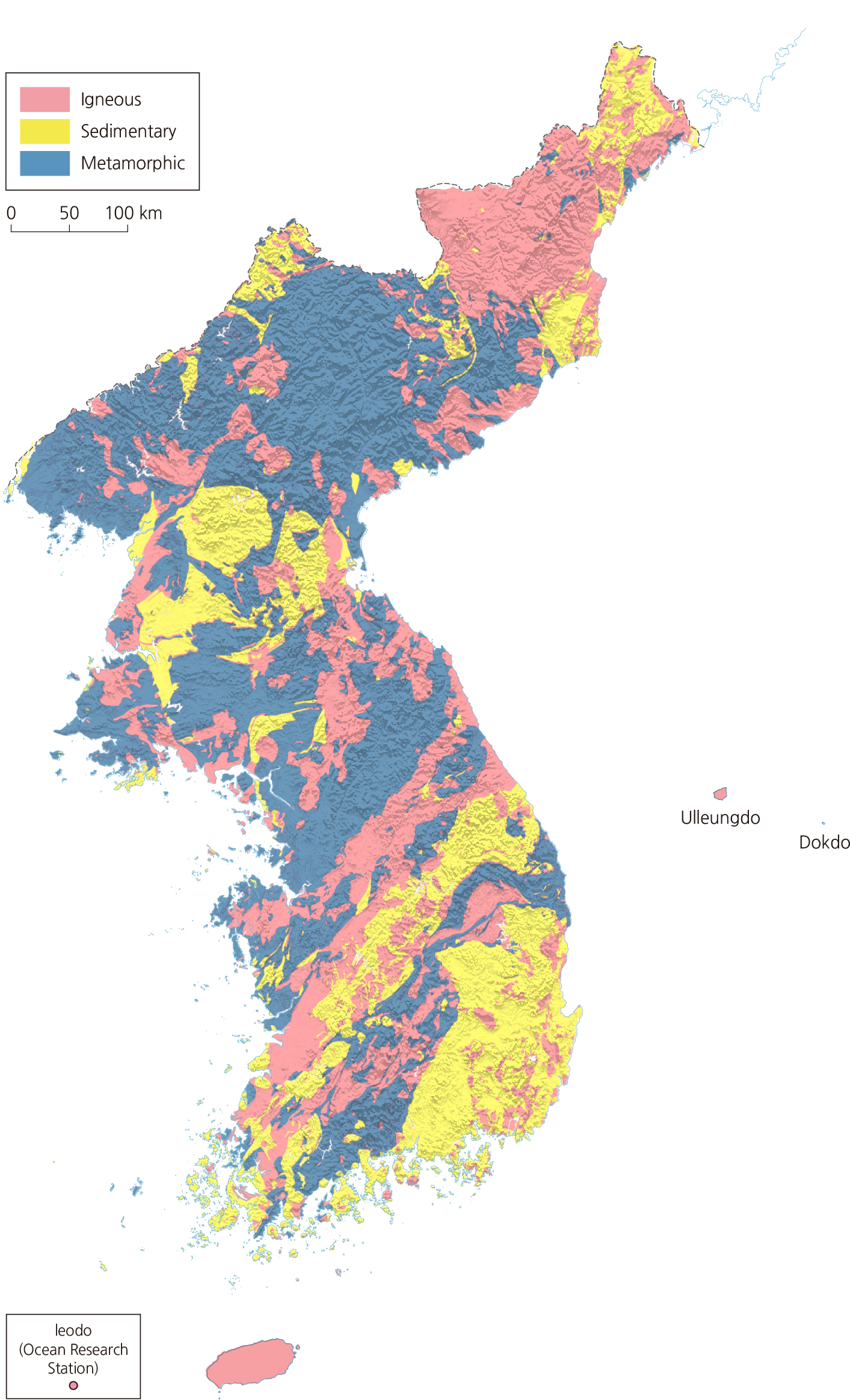Comprehensive Edition 2022
<map> The Rock Cycle
Korea has a diverse and interesting geologic history and owes much of its natural beauty to the rocks underneath the landscape. Bedrock that is resistant to weathering and erosion forms high rugged mountains, while less resistant rocks characterize the lowlands, basins, and valleys. Sites of geological significance have been preserved as twenty-two National Parks, seven Geoparks, and nine Ecological Landscape Conservation Areas across the country.
This geologic map has been simplified to show the locations of the three main rock types: igneous, sedimentary, and metamorphic. Any of these rock types can be transformed to any other type through the rock cycle. More than two-thirds of the Korean Peninsula consists of igneous and metamorphic rocks. By studying rocks and their distributions, geologists can work out the ancient history of Korea as it was shaped by volcanism, tectonic plate movements, erosion, and the sedimentary history that goes back billions of years. The oldest rocks in Korea are about 2.5 billion years old.
The geology of the Korean Peninsula is important for interpreting the tectonic relationship between Korea, China, and Japan. As the East Sea was formed, it separated Japan from Korea and uplifted the eastern part of the Korean Peninsula. Due to the uplift, the eastern part of the Korean Peninsula was elevated higher than the western part, resulting in westward tilting. The Peninsula is relatively, but not completely, safe from earthquakes compared to Japan, which is located on the plate margin. Although not abundant in most cases, many kinds of mineral resources have been found on the Korean Peninsula.
<photograph> Igneous Rock Forms by solidifying directly from a molten state. The most common igneous rock in Korea is granite, which solidifies while the body of molten magma is still underground. Many granite and volcanic rocks in Korea were formed during the Mesozoic period about 250 to 66 million years ago. Most granites are milk-white in color but alkali granites show a pinkish red color.
<photograph> Sedimentary Rock is formed by the consolidation of sediments that have accumulated in an area. Many sedimentary rocks in Korea were deposited during the Tertiary period (66 to 2.5 million years ago) and the Quaternary period (2.5 million year ago until the present). The main sedimentary rocks are shale, sandstone, conglomerate, and limestone.
<photograph> Metamorphic Rock is formed by applying heat and pressure to a rock to physically or chemically change it. Most metamorphic rock in Korea formed in the Pre-Cambrian period (more than 540 million years ago). In Korea, metamorphic rocks consist of mainly gneiss and include schist, phyllite, quartzite, marble, and amphibolite, which formed by the metamorphism of shale, sandstone, limestone and basic igneous rocks.
<map> Geologic Mapping
The Korea Institute of Geoscience and Mineral Resources produces geologic maps at a variety of scales. The Geologic Map of Korea (1: 1,000,000) has been revised several times, with the final version published in 2019. Maps at a scale of 1: 50,000, such as the one shown here, have been made to cover the entire Korean Peninsula. These maps also feature geologic cross-sections, or vertical profiles, which show stratigraphy and faults. Geologic maps of 1: 250,000 and 1: 25,000 scales have also been published, along with other maps for special purposes. In addition to their utility for practical purposes, these geologic maps in themselves represent beautiful works of art.
<map> Distribution and Types of Fossil Footprints of Major Vertebrates in the Cretaceous Period
Traces of Dinosaurs
Dinosaurs roamed the Korean Peninsula during the Cretaceous period, 145 to 66 million years ago. Terrestrial (i.e., non-marine) sedimentary rocks from this time period occur on the southern end of the Korean Peninsula and contain abundant dinosaur fossils, including footprints and egg and bone fossils. Dinosaur footprint fossil sites are found in the southern region of the Korean Peninsula. The variety of size, shape, and trackway patterns of footprints indicate that diverse sauropods, ornithopods, and theropods lived on the Korean Peninsula. The pterosaur found in Uhangri, Haenam-gun, was recently approved as a new species, named Haenamichnus uhangriensis. The largest number (443) and the widest trackway (7.3 m) of pterosaur footprints are found in the Uhangri area. In this area, the footprints of pterosaurs, dinosaurs, and birds occur together in the same sedimentary layer, a rare occurrence. |






